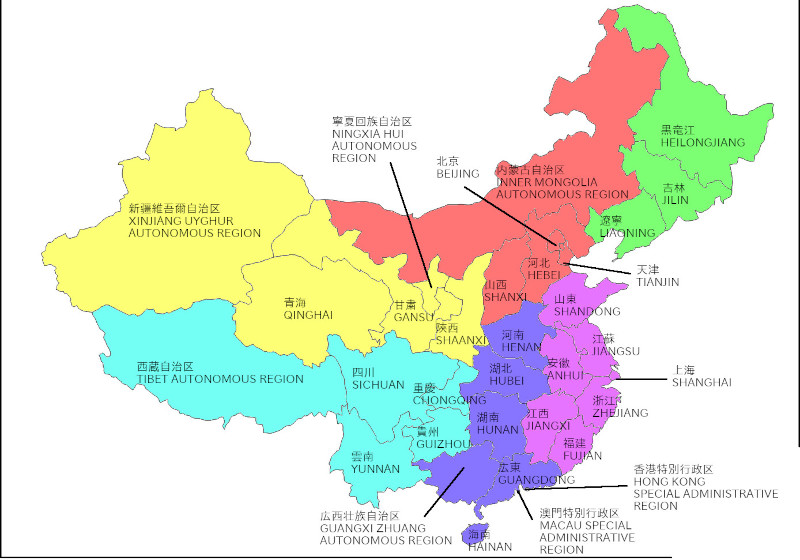TOP/UPDATES/FOUR PILLARS/CINEMA+TV/GAMES/MANGA+ANIME/MUSIC/WRITINGS/FAQ/LINKS
TOP/UPDATES/FOUR PILLARS/CINEMA+TV/GAMES/MANGA+ANIME/MUSIC/WRITINGS/FAQ/LINKS
Today China has 22 Provinces (and 1, Taiwan, that is claimed but not administered), 4 Municipalities, 5 Autonomous Regions, and 2 Special Administrative Regions, which are traditionally grouped into six regions.

|
|
|
|
|
*北京・BEIJING *天津・TIANJIN *河北・HEBEI *内蒙古自治区・INNER MONGOLIA AUTONOMOUS REGION |
*河南・HENAN *広西壮族自治区・GUANGXI ZHUANG AUTONOMOUS REGION *海南・HAINAN *香港特別行政区・HONG KONG SPECIAL ADMINISTRATIVE REGION *澳門特別行政区・MACAU SPECIAL ADMINISTRATIVE REGION |
|
|
|
|
|
|
*貴州・GUIZHOU *雲南・YUNNAN *西蔵自治区・TIBET AUTONOMOUS REGION |
*遼寧・LIAONING *黒竜江・HEILONGJIANG |
*甘粛・GANSU *青海・QINGHAI *寧夏回族自治区・NINGXIA HUI AUTONOMOUS REGION *新疆維吾爾自治区・XINJIANG UYGHUR AUTONOMOUS REGION |
China is one of the oldest civilizations on earth. It was one of the early birthplaces of modern agriculture as the low-lying and fertile floodplains of the Yellow and Yangtze Rivers provided an ideal location, just like the Nile in Egypt and the Tigris and the Euphrates in Mesopotamia. China has a very rich culture of writing and historiography, and has had so for a longer time than many others. The early invention and adoptation of paper is a major reason for it. The "Axial Age" of around the 6th century to 4th century BC saw a major proliferation of philosophical and intellectual growth in China. The figure who would emerge from it as dominant was Confucius, who has created many of the foundations of morality in East Asia. Laozi, the founder of the tradition known as Daoism, was also born in this period. Both Confucianism and Daoism became refined, multifaceted traditions due to the innovations of later thinkers such as Mencius and Zhuangzi. China was at this time a series of small, warring kingdoms. It would be united in 221 BC by Qin Shi Huang, the first "emperor" of China. He was violent and ruthless and burned the records and treatises of his rivals, leading to a lot of missing knowledge about ancient China.
Buddhism was introduced to China around the 6th century AD and soon became its dominant religion, though always with some tension with native Confucianism. The Tang and Song Dynasties of unity were cultural golden ages. Many of China's greatest poets like Du Fu and Li Bai flourished. The Chan Buddhist tradition (known as Zen in Japan) became refined and developed. China occasionally lost unity and collapsed back into warring states, which made the empire weak to the invasions of nomadic tribes from the steppes, especially the Mongols. This culminated in 1271 with the founding of the Yuan Dynasty, during which China was officially ruled by Mongolians. In 1368, the native Han Chinese took control back of the empire and founded the Ming Dynasty. Most of what we now see of the Great Wall of China was built to deter nomadic invaders. Trade with the west increased. Confucianism experienced a revival after Vajrayāna Buddhist hegemony under the Mongols. In 1644, the Ming fell and the Qing Dynasty began, which was led by another steppe people known as the Manchu. China became quite powerful and influential in global trade. Much of the western half of what is known today as "China" was first annexed during the Ming and Qing. But this dominance eventually led to tensions with western powers. The Opium Wars with Britain occurred when Britain failed to control the flow of opium into China. It was a very socially destructive drug. China languished during the 1800s and came close to being divided up by imperial European and Japanese powers.
In 1911, revolutionaries led by Sun Zhongshan officially deposed the last Qing Emperor and turned China into a modern republic. After Sun Zhongshan's death, Jiang Jieshi led mainland China as a one-party state via his party known as the Guomindang after 1927. The Guomindang descended into a civil war against its former ally, the Chinese Communist Party led by Mao Zedong. After a temporary truce to fight off Japanese forces that invaded in the late 1930s, the struggle ended with Jiang Jieshi and the Guomindang exiled to Taiwan and Mao Zedong's CCP taking over mainland China. Mao rapidly industrialized mainland China and dramatically improved the lives of many peasants. His mishandled economic policies created the largest man-made famine in history. After this came a brutal period of country-wide, guerilla-style political repression known as the Cultural Revolution. Huge numbers of the political old-guard were forcefully removed, historical artifacts and documents were destroyed, Buddhist monks were forced to denounce their religion, and countless people were tortured, imprisoned, and killed on the mere suspicion of being anti-revolutionaries. After Mao's death, Deng Xiaoping opened China to the neoliberal world economy. Society was far freer than it was under Mao, but China would certainly not become a liberal democracy, as the Tiananman Square massacre of 1989 demonstrated. The country is now one of the major economic and political powers in the world. Its government unfortunately remains quite repressive and totalitarian, although paranoia over its foreign influence is usually overstated.